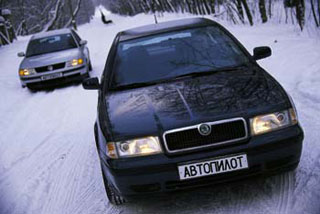Skoda Octavia I test drive - 2010 -
Useful and tasty
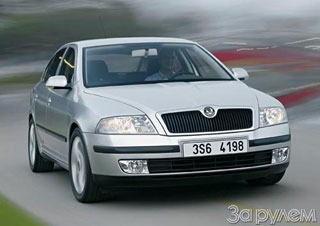 They have been waiting for a new octavia for a long time. Her predecessor allowed Skod to take a worthy place in the hierarchy of European brands, but it was in 1996. Then Octavia became the first car built on the Volkswagen-Golf IV platform, and appeared earlier for a whole year. But in 2003, the premieres of the second Audi A3 and the fifth golf took place, and the new Octavia, which shares with the Germans of the chassis and some power units, had to wait a few more months.
They have been waiting for a new octavia for a long time. Her predecessor allowed Skod to take a worthy place in the hierarchy of European brands, but it was in 1996. Then Octavia became the first car built on the Volkswagen-Golf IV platform, and appeared earlier for a whole year. But in 2003, the premieres of the second Audi A3 and the fifth golf took place, and the new Octavia, which shares with the Germans of the chassis and some power units, had to wait a few more months. Old and new
It is easiest to identify the new octavia in front, although here, perhaps, there is too much in common with the predecessor: a characteristic decorative grille of the radiator, protruding the checkpoint in the center of the hood, the bumper line. The form of headlights that received crystal optics became more comfortable, the opening of the rear door, the hood and the front racks have changed more conveniently.
The main disadvantage of the previous model, especially if you take into account the image of the family machine, consider a close rear seat. The passenger above the average height rested his head against the ceiling, and with a rather big driver, his knees in his chair. An enlarged wheelbase and new seats with more thin backs made it possible to carry out previously inconceivable: two heights 190 cm can, albeit without unnecessary freedom, fit one after another.
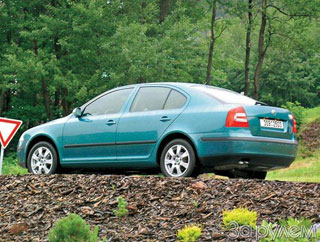 Suddenly, the Bumpers were pleased with the designers of Skoda, apparently, not without pressing customers, they returned to individual lower parts of black plastic. Probably, even in prosperous Europe, where the height of the curbs is less than anti -tank escarps, there were many dissatisfied with who had to fork out on an expensive bumper after careless parking. Gum along the contour of the bumper is also real, removable. A commendable example, even in expensive A3 A3, is occupied by fake plastic plastic stampings.
Suddenly, the Bumpers were pleased with the designers of Skoda, apparently, not without pressing customers, they returned to individual lower parts of black plastic. Probably, even in prosperous Europe, where the height of the curbs is less than anti -tank escarps, there were many dissatisfied with who had to fork out on an expensive bumper after careless parking. Gum along the contour of the bumper is also real, removable. A commendable example, even in expensive A3 A3, is occupied by fake plastic plastic stampings. Skoda Octavia is now represented with five types of engines: three gasoline and two turbodiesel. The most modest 1.4-liter gasoline engine is familiar from many models of Volkswagen. But in the 1.6-liter volume there are two units at once: known as the previous Octavia 75 kW/102 liters. With. with two valves for a cylinder and a new FSI with a direct injection of 85 kW/115 liters. With.
Skoda marketers say: today, more than 60% of the machines sold are equipped with diesel engines, and their share is constantly growing. In this regard, it is hardly a surprise that the most powerful octavia is diesel. Two direct injection engines are equipped with turbocharges and pumps. Smaller, with a volume of 1.9 liters, with two valves per cylinder; Two-liter 140-horsepower with four. In general, for the debut, the set is worthy.
The author managed to get acquainted only with diesels and the most powerful gasoline ... although who knows, maybe they will be the most popular on our roads?
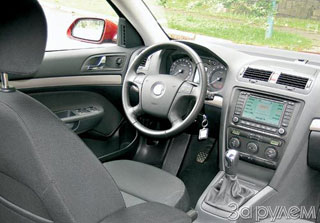 Elegant and direct
Elegant and direct The July Czech Republic met us not at all summer weather. Low cloudy, incessant rain and narrow mountain roads in the vicinity of the Liberets, in the very north of the country, near the border with Germany and Poland.
The car of the first sample with the FSI engine and in the Eleans configuration. The steering wheel with the audio system buttons is sheathed with leather, a huge color display in the center of the dashboard is given to the navigation system, a climatic installation with separate regulation. But the seats are ordinary, mechanical, and the attempt to move back (the car was on the rise) led to an unexpected measurement of the driver's seat. The chair quickly left to the stop, so with a height of 176 cm, I reached the pedals only by socks of the boots, and two fists were left above my head. Mentally add 15 cm to the legs and the body even a driver in two meters tall will not touch the head of the ceiling. The number and range of adjustments of the seats and the steering wheel are optimal, there is no need to look for your landing for a long time. Even a fashionable armrest between the seats does not interfere with switching the gears.
The engine pulls well from 1,500 rpm and marks noticeably after three and a half thousand. At the same time, despite the fulfillment of the ecological norms of Euro IV, it quickly responds to the gas pedal and does not cause inconvenience during touching. Only at idle does the motor gives out a characteristic clatter of nozzles. There is nothing to do the high pressure of the injection system generates such a feature. With intensive acceleration, the sound of the engine seems unnecessarily tough, reminiscent of racing motors, but at the same time the overall noise level is quite within the comfort of comfortable. Nevertheless, the dynamics of Octavia did not cause a flurry of emotions. But the press release claims that the fuel consumption with the FSI engine is lower by an average of 10%.
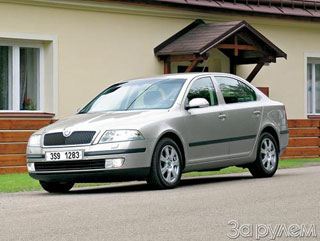 The Bridgeto-Tenter 225/45ZR17 shod in low-profile tires, Octavia demonstrates not at all a family level of lateral accelerations. True, it did not reach the slippers of two and a half Skoda, replete with closed turns and oncoming cars, did not particularly have it. Even on wet coating, powerful tires do not allow the drive wheels to slip under the thrust. As for the work of the brakes, the slowdown for wet coating is impressive, ABS works almost imperceptibly when it seems that the wheels are already slipping. It is difficult to find fault, even if you want.
The Bridgeto-Tenter 225/45ZR17 shod in low-profile tires, Octavia demonstrates not at all a family level of lateral accelerations. True, it did not reach the slippers of two and a half Skoda, replete with closed turns and oncoming cars, did not particularly have it. Even on wet coating, powerful tires do not allow the drive wheels to slip under the thrust. As for the work of the brakes, the slowdown for wet coating is impressive, ABS works almost imperceptibly when it seems that the wheels are already slipping. It is difficult to find fault, even if you want. White and red
Outside, two diesel octavias differ only in the color of the letter I in one, one has white, the other is red. In fact, the differences are much more noticeable. A car with white I is equipped with an eight -valve engine and a five -speed gearbox. Two or three years ago, his characteristics could only be spoken in excellent degrees, but modern diesel engines progress so quickly that leaders change almost once every six months. White TDI perfectly pulls above 1,500 rpm, touches well, accelerates perfectly if
If you do not know about a car with a red letter. After it, I do not want to return to 105-horsepower Octavia. And the point is not at all in the extra 35 horses. A two-liter 16-valve diesel is much wider in range, spins easier and vibrates much less. Of course, it also wins below 1,500 rpm, but at this mark it demonstrates an impressive torque, easily turning the front wheels even in second gear.
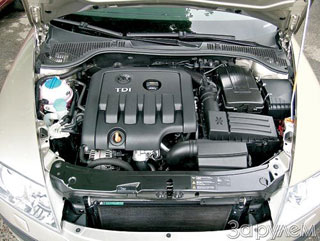 A six -speed box allows you to use all the engine capabilities in any speed range. On the suburban highway, you often do not have to contact it above 80 km/h you can safely go to the sixth and allow yourself frisky overtaking. In the city, one has to be pretty wielded with a lever: the car does not go at low speeds, above 3000 it becomes too sensitive to the slightest movement of the gas pedal, forcing passengers to strain.
A six -speed box allows you to use all the engine capabilities in any speed range. On the suburban highway, you often do not have to contact it above 80 km/h you can safely go to the sixth and allow yourself frisky overtaking. In the city, one has to be pretty wielded with a lever: the car does not go at low speeds, above 3000 it becomes too sensitive to the slightest movement of the gas pedal, forcing passengers to strain. So the automatic transmission will be a great pair of any of the turbodiesel. So far, it is available only with a weaker motor. And what a transmission! The same DSG, with two clutches, the acquaintance with which first occurred on Audi TT (ZR, 2004, No. 8). It seems that here it will be no worse.
* * *
What should be the perfect octavia? Discussing this issue with colleagues, they gathered together what they liked the most. This is a powerful diesel plus automatic DSG gearbox, combining the smoothness of the machine gun and the effectiveness of mechanics. Among the bodies, preference was given to a station wagon, whose debut is only expected. As for the full drive, opinions were divided in half. Equipment? This is already a matter of taste and finance.
In the Russian market, new cars will appear in the fall. It can be predicted that Skoda Octavia will be approximately 10% more expensive than its predecessor. Well, the image of Skoda as the most practical car of built on a single platform is unlikely to be able to shake. It is important that among its advantages, a considerable place is occupied by the pleasure of driving: not only useful, but also tasty.
Anatoly Fomin. Photo by the author and Skoda
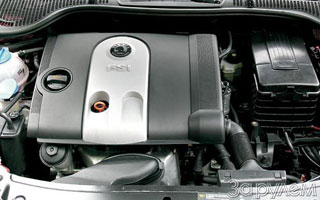
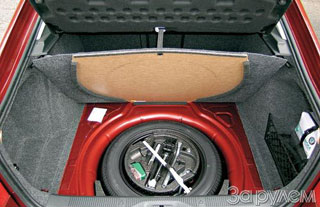
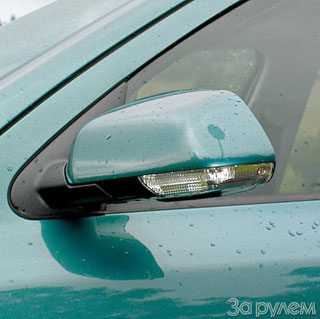
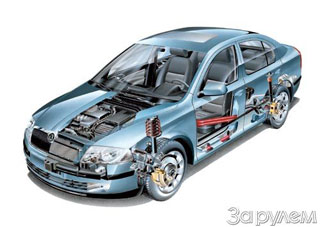
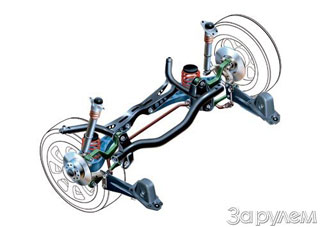
Source: The magazine "Driving"
Video Crash tests Skoda Octavia I 1997 - 2010
Skoda Octavia I 1997 - 2010 test drives
Skoda Octavia I Crash Test - 2010
Krassh Test: Detailed Information25%
Driver and passengers
14%
Pedestrians
Malfunctions Skoda Octavia I 1997 - 2010
Skoda Octavia malfunctions: Detailed information| Octavia I 1997 - 2010 | |
|---|---|
| Engine |  |
| Transmission |  |
| Control system and suspension |  |
| Brake system |  |
| Air heating and air conditioning |  |
| Launch and charging system |  |
| Electric components and so on |  |
| Corrosion body stability |  |









